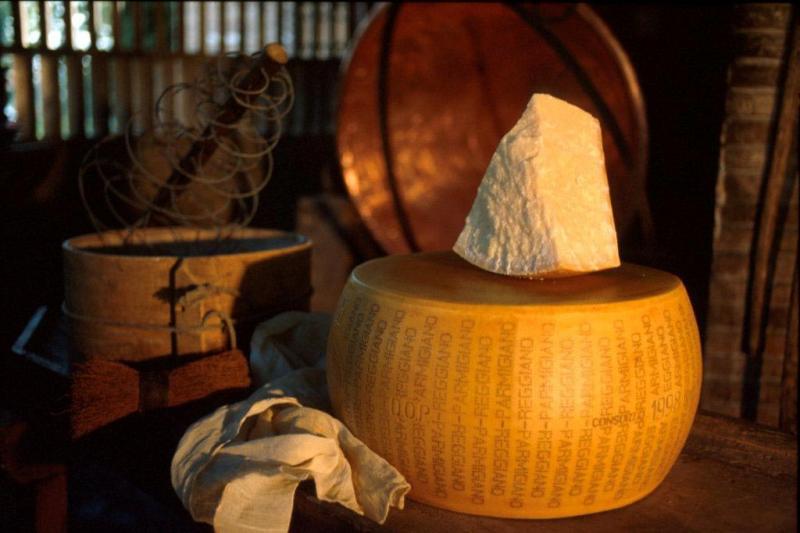 Everything begins with the region’s unique soil and climate which determine the flavors and nutrients of the grass fed to the cows, Of course, this is also reflected in the taste of the milk, the basic ingredient of Parmigiano cosidering that about 550 liters of milk are used to produce one wheel of this famous cheese. Then, it’s the turn of the modern-day mastri casari (cheese-makers) who give Parmesan cheese its shape and texture. Finally, once the production phase is complete, the equally important aging phase begins.
Wheels remain in the aging room a minimum of 12 months. At that point, experts from Consorzio Parmigiano-Reggiano examine each wheel with a special hammer to make sure they comply with the rigorous standards of the consortium. If requirements are met, the wheels are fire-branded with the famous oval certification mark. Most wheels are left to age for another 12 months, as 24 months is the ideal aging time.
Parmigiano-Reggiano and its characteristics
Everything begins with the region’s unique soil and climate which determine the flavors and nutrients of the grass fed to the cows, Of course, this is also reflected in the taste of the milk, the basic ingredient of Parmigiano cosidering that about 550 liters of milk are used to produce one wheel of this famous cheese. Then, it’s the turn of the modern-day mastri casari (cheese-makers) who give Parmesan cheese its shape and texture. Finally, once the production phase is complete, the equally important aging phase begins.
Wheels remain in the aging room a minimum of 12 months. At that point, experts from Consorzio Parmigiano-Reggiano examine each wheel with a special hammer to make sure they comply with the rigorous standards of the consortium. If requirements are met, the wheels are fire-branded with the famous oval certification mark. Most wheels are left to age for another 12 months, as 24 months is the ideal aging time.
Parmigiano-Reggiano and its characteristics
 Parmigiano-Reggiano is made with raw milk; it is easy to digest, rich in proteins, calcium, phosphorus, vitamins and minerals. Its cholesterol content is only 80 - 85mg/100g, much lower than other full fat cheeses. As a matter of fact, the combination of these nutritional benefits and low fat content explain why in Italy doctors recommend Parmesan as an ideal food to infants, teenagers and the elderly as well as to athletes.
Parmigiano-Reggiano is a very versatile cheese and, depending on its aging time, it is best combined with certain foods and wines:
AS AN APPETIZER: Aged 18 months. This is the best Parmigiano to use as an appetizer. It is ideal with raw vegetables, celery and sweet little tomatoes. To enhance its delicate flavor, try it with fruit mustard, such as apricot and melon. To be served with a glass of dry white wine.
TO ADD FLAVOR TO PASTA AND SOUPS: Aged 24 months. Perfect with pasta, risotto, soups, either grated or in flakes.
WITH MEAT AND SEAFOOD: Aged 22 to 30 months. Ideal for carpacci, cut in thin flakes, with arugula and just a drop of olive oil. This aging time goes well with more robust red wines.
WITH VEGETABLES AND SALADS: Parmigiano-Reggiano is perfect with fresh salads and seasonal vegetables; it is an essential ingredient for making quiches, baked vegetables and some traditional recipes, like eggplant parmigiana.
WITH FRESH FRUIT AND NUTS: Aged 15 to 18 months. Fantastic with fresh fruit such as pears, apples, grapes and strawberries. Aged 24 to 28 months is perfect with dry fruit such as figs and plums, as well as walnuts and hazelnuts.
WITH BALSAMIC VINEGAR: Finally, cut a thick flake of 30 to 36-month-old Parmigiano and taste it with a drop of traditional balsamic vinegar from Modena or Reggio Emilia. Simply delicious!
To see the “mastri casari” in action you can book a guided visit of a caseificio.
Parmigiano-Reggiano is made with raw milk; it is easy to digest, rich in proteins, calcium, phosphorus, vitamins and minerals. Its cholesterol content is only 80 - 85mg/100g, much lower than other full fat cheeses. As a matter of fact, the combination of these nutritional benefits and low fat content explain why in Italy doctors recommend Parmesan as an ideal food to infants, teenagers and the elderly as well as to athletes.
Parmigiano-Reggiano is a very versatile cheese and, depending on its aging time, it is best combined with certain foods and wines:
AS AN APPETIZER: Aged 18 months. This is the best Parmigiano to use as an appetizer. It is ideal with raw vegetables, celery and sweet little tomatoes. To enhance its delicate flavor, try it with fruit mustard, such as apricot and melon. To be served with a glass of dry white wine.
TO ADD FLAVOR TO PASTA AND SOUPS: Aged 24 months. Perfect with pasta, risotto, soups, either grated or in flakes.
WITH MEAT AND SEAFOOD: Aged 22 to 30 months. Ideal for carpacci, cut in thin flakes, with arugula and just a drop of olive oil. This aging time goes well with more robust red wines.
WITH VEGETABLES AND SALADS: Parmigiano-Reggiano is perfect with fresh salads and seasonal vegetables; it is an essential ingredient for making quiches, baked vegetables and some traditional recipes, like eggplant parmigiana.
WITH FRESH FRUIT AND NUTS: Aged 15 to 18 months. Fantastic with fresh fruit such as pears, apples, grapes and strawberries. Aged 24 to 28 months is perfect with dry fruit such as figs and plums, as well as walnuts and hazelnuts.
WITH BALSAMIC VINEGAR: Finally, cut a thick flake of 30 to 36-month-old Parmigiano and taste it with a drop of traditional balsamic vinegar from Modena or Reggio Emilia. Simply delicious!
To see the “mastri casari” in action you can book a guided visit of a caseificio.








